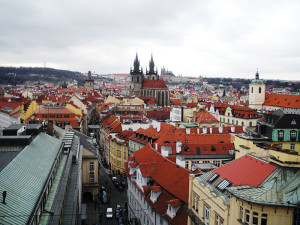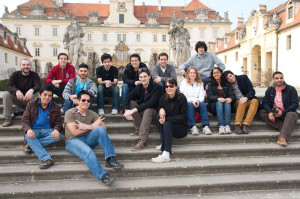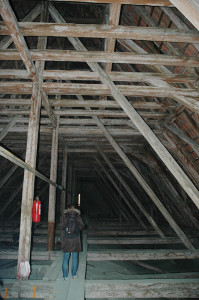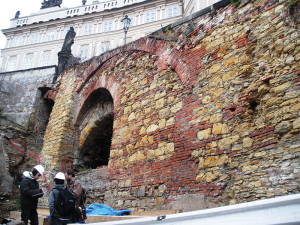A Look Inside the Advanced Masters in Structural Analysis of Monuments and Historical Constructions
Imagine studying historic restoration while surrounded by historic structures and conservation experts in a city with over two thousand years of history. Is there any better way to learn?
Europe Bound
While finishing up my undergraduate degree, I began researching graduate programs. I had a strong interest in historic preservation and rehabilitation, and wanted to pursue further education in this subject area. I looked at many programs offered in North America, but they were mainly geared towards architects. As an engineer, I wanted to find a program that had a focus on structural stability and analysis of historic structures, as well as aesthetics and material preservation. When restoring a historic structure, it is important to understand the structural system and how it was built in order to ensure its stability for future generations. The North American programs in restoration do not offer this type of focus; they are architecturally oriented. While interviewing for an engineering post-graduate position at a university in Canada, a professor told me about the Advanced Masters in Structural Analysis of Monuments and Historical Constructions (SAHC) program. After researching the program further, I knew I had found the perfect match for my interests and engineering background.
The SAHC Masters Program
The SAHC masters program is a one-year Master of Science program on the engineering of conservation of structures, with a focus on architectural heritage. It consists of both coursework and a dissertation. Coursework is concentrated in two countries each year, and dissertation work is divided between all involved institutions. The academic institutions involved in the program are the University of Minho, Portugal, Czech Technical University in Prague, Czech Republic, the University of Padova, Italy, the Technical University of Catalonia, Spain, and the Institute of Theoretical and Applied Mechanics, Czech Republic. The coursework consists of six units including History of Construction and of Conservation, Structural Analysis Techniques, Seismic Behaviour and Structural Dynamics, Inspection and Diagnosis, Repairing and Strengthening Techniques, Restoration and Conservation of Materials, and an Integrated Project.
It is an international program that is taught in English. In my 2012 graduating class, there were students from Australia, Canada, France, Greece, India, Italy, Mexico, Peru, Portugal, Serbia, Spain, South Korea, Turkey, and U.S.. Professors from all over Europe and the world came to give us lectures on their areas of expertise. I performed my coursework at the Czech Technical University in Prague with thirteen other students. Prague (Figure 1) is a beautiful and architecturally rich city with buildings that date back almost a thousand years. I worked with Professor Maria Rosa Valluzzi and Professor Claudio Modena during my dissertation at the University of Padova. The title of my dissertation thesis was Kinematic Analysis and Intervention Design of a Complex Building Aggregate in Villa Santa Lucia degli Abruzzi in L’Aquila Province. The thesis was a study of the seismic vulnerability of a historic masonry building in a province of Italy that has high seismic hazard. The research focused on the collapse mechanisms of the building and various intervention techniques to prevent failure in future earthquakes. I recently published a paper and presented on this same topic at the 9th International Masonry Conference in Guimarães, Portugal.
The SAHC masters program was a very enriching experience for me. It was a great opportunity to study in a different country with people from all over the world. My professors and classmates taught me a lot about engineering and conservation practices in their home countries. I built many strong friendships with my classmates and learned about their different cultures. It was incredible to study historic conservation in a place like Europe, where there are historic masonry buildings at every turn. The coursework material came to life during our field trips to historic structures around the Czech Republic and Italy. Figure 2 is a class photo taken during a field trip to Valtice Chateau in the region of Southern Moravia in the Czech Republic.
The courses focused on conservation from a structural and material degradation point of view. They were academically rigorous and very interesting. One of my favorite courses was History of Construction and of Conservation. In this course, we explored the different restoration strategies throughout history, learned about historic construction and design techniques, and discussed damage mechanisms for masonry and timber structures. In Figure 3, I am completing a building evaluation in the attic of the Church of Our Lady Victorious in Prague for one of the class assignments. I also especially enjoyed the Restoration and Conservation of Materials course. In this course, we learned about the material properties of historic masonry and other common building materials, how they degrade, and how they can be restored. There were also many lab experiments as part of this course, with lots of hands-on experience. As part of the Integrated Project course, I studied the structural stabilization and moisture remediation of a historic monastery, as well as the damage mechanisms of a medieval stone arch, seen in Figure 4.
Bringing My Knowledge Back Across the Atlantic
Since graduating from the SAHC masters program, I have worked at Ryan Biggs | Clark Davis Engineering & Surveying, P.C. (formerly Ryan-Biggs Associates), a consulting firm in New York State specializing in structural engineering, civil engineering and surveying. I specialize in structural restoration services including non-destructive testing, building investigations, masonry restoration, timber rehabilitation, and renovations of historic structures. The knowledge and experience I gained from the SAHC program has been incredibly useful. The analysis, inspection, diagnosis, and non-destructive testing techniques I learned while overseas have been particularly relevant to my work.
North America has a rich architectural history and many historic structures. Although they are not as old as many of the structures in Europe and other parts of the world, they played a significant part in our history and should be preserved for future generations. In order to preserve these structures, engineers must understand historic construction techniques, materials, and structural systems in order to design suitable restoration and rehabilitation strategies. The SAHC masters program provides a wealth of information that we can use in North America to preserve our historic structures and keep the past alive.
I would recommend the SAHC masters program to all engineers who are interested in historic restoration and rehabilitation. It is a beneficial program for both those who have recently finished their undergraduate degrees, and those who have been practicing engineering but would like to become more specialized in historic structures. The program is geared towards those with engineering backgrounds. However, architects with technical backgrounds will also find this program worthwhile. The SAHC masters program is very unique and provides an incredible opportunity to travel, to study with engineering students from all over the world, and to learn from a diverse group of experts from leading European universities in the field of conservation. It is an excellent program and I highly recommend it.
For more information about the SAHC masters program, please visit www.msc-sahc.org/.▪




